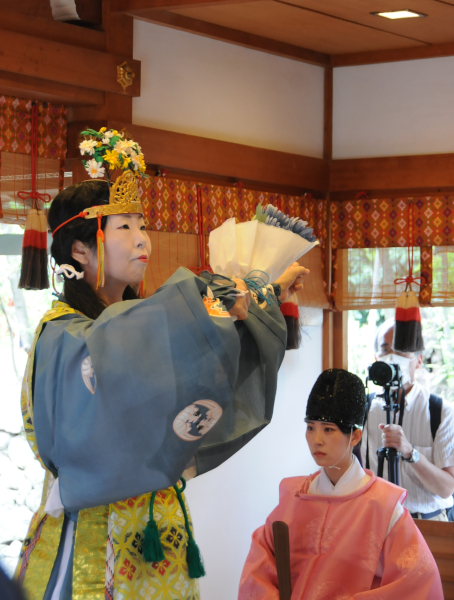September 9 is one of the special days in the Japanese calendar. It is the day of the Chrysanthemum Festival, also called choyo or kikku-no-sekka, and many shrines and temples have ceremonies to pray for health and, in particular, longevity. This is because 9. 9. is the largest single-digit day possible, and so there is a connection. Looking at the Japanese statistics of people who lived beyond 99 years of age, the prayers actually seem to work.
In Kyoto, the most famous Chrysanthemum Festival is at Kamigamo Shrine, where there is karasu sumo, a special event with kids performing sumo for the gods. I visited this event already in 2013, you can read about my impressions in the post I did then.
So, today I had to go elsewhere, partly also because the karasu sumo was cancelled because of Covid19. Many other shrines have cancelled their events too, so I decided to visit Kuramazaki Jinja who promised a special dance for the occasion. I have passed the shrine before, on my visits to Arashiyama, and it looked interesting, so off I went just before noon.
At Kuramazaki Jinja, the kikku-no-sekka ceremony started with the usual prayers to the gods, accompanied by gagaku music. Then, different types and colors of chrysanthemums were offered to the gods in a comparatively short but nevertheless solemn ceremony. Afterwards, there was indeed a dance performance by a female dancer who also held chrysanthemums in her hands during the dance. For some reason, the music for her performance came from a tape, I did not quite understand why, since there were gagaku players present. Finally, guests to the ceremony were allowed to make their offerings to the gods as well.

Altogether, the ceremony took about 30 minutes. I felt that it had been scaled down from its usual size. For one, there was no chrysanthemum sake offered to the visitors because of Covid19. Also, I believe there should have been more performances of music and dance after the religious ceremony, but whether they were cancelled because of Corona or because of the rain, I am not sure.
One thing that struck me immediately: There was a woman among the priests of the shrine. I have never seen this before. Usually, all the priests are male, and the only women allowed near the gods are the miko, the shrine maidens, who to this day have to be unmarried women. And here, there was a young female priest, and she even seemed to lead the ceremony. Slowly, slowly, even Japan is changing. Maybe.

I believe, there is a long tradition of Buddhist nuns, starting somewhere in the 13th or so century.
I remember watching a documentary on NHK about an all female temple. Well, it was a documentary about Buddhist cuisine and stuff throughout the year. 🙂
and, I actually found it on the website: https://www.nhk.jp/p/ts/78293ZQNMM/
やまと尼寺 精進日記/献立帳
You can see Buddhist nuns every now and then at the big temples. As far as I remember, many of the wives of emperors would become nuns upon the death of their husbands or possibly, already when they retired (and who often took the tonsure themselves). There is even a famous story about Taira no Kiyomori (11th century) and his lover Gio, who, when replaced by a younger version of herself, also becomes a nun. “Gio” is now a famous Noh play.